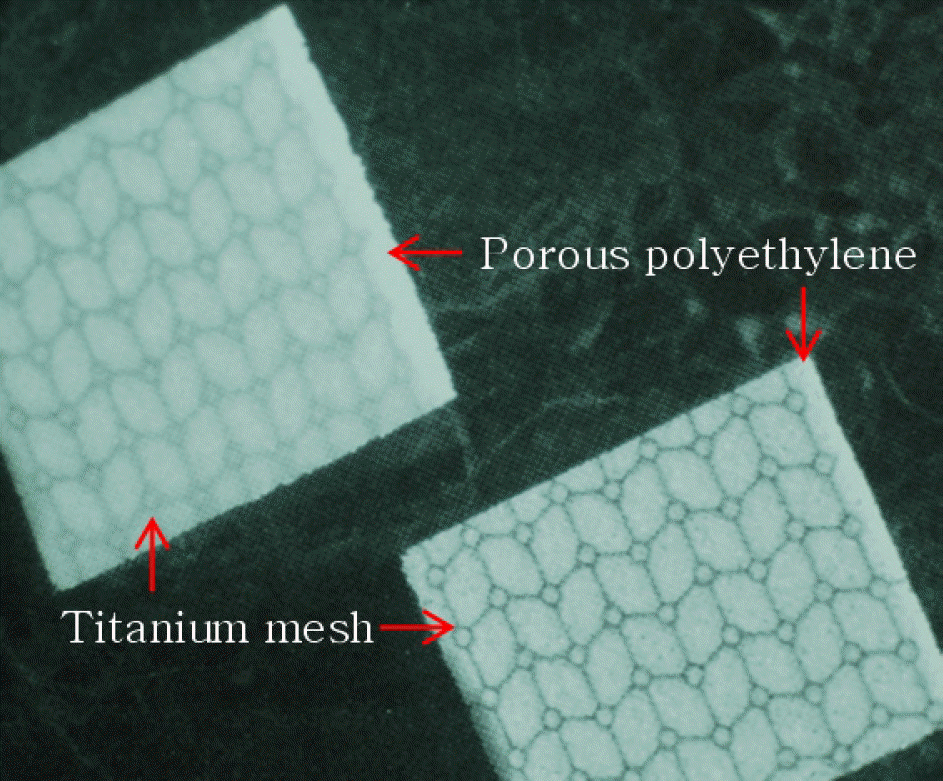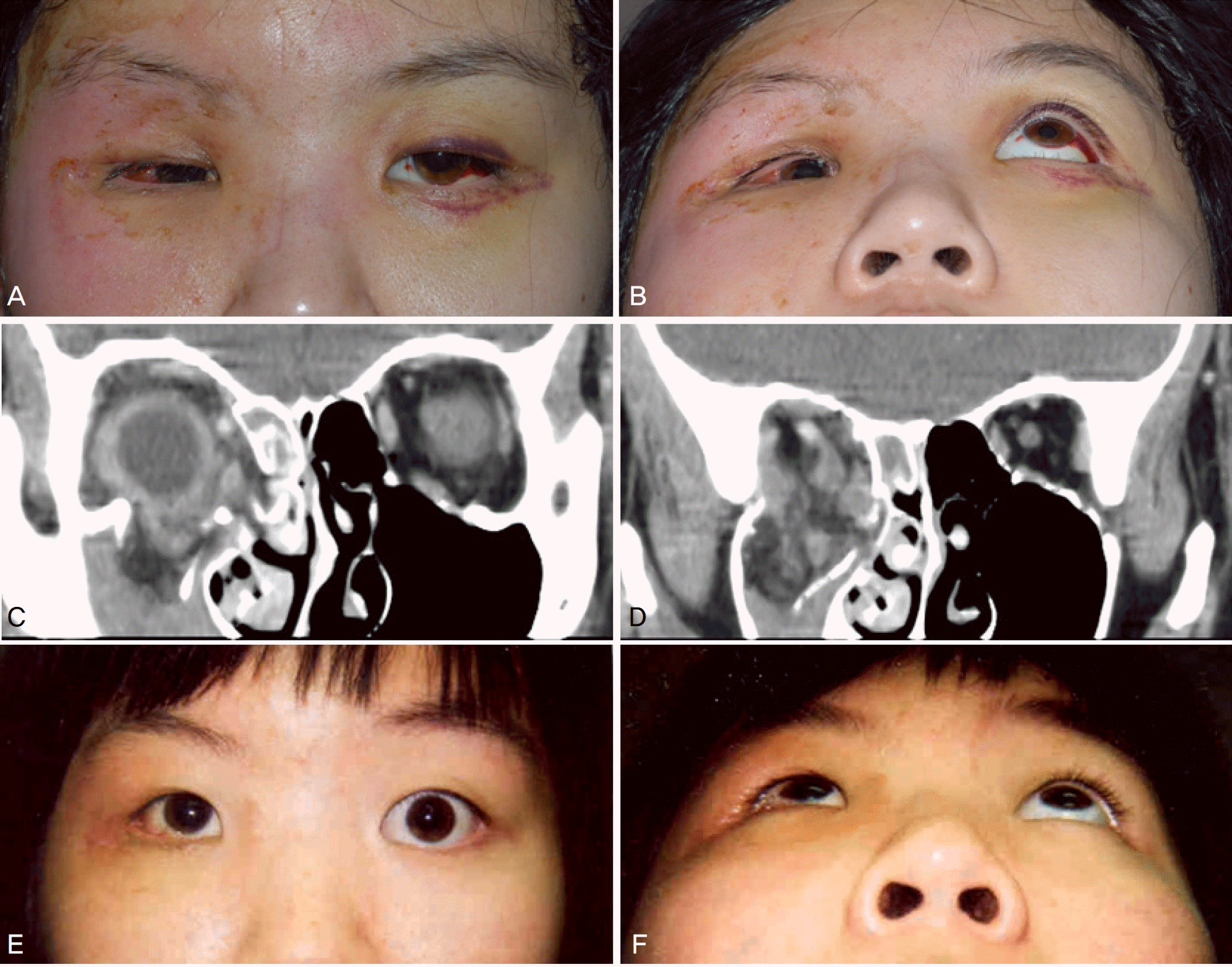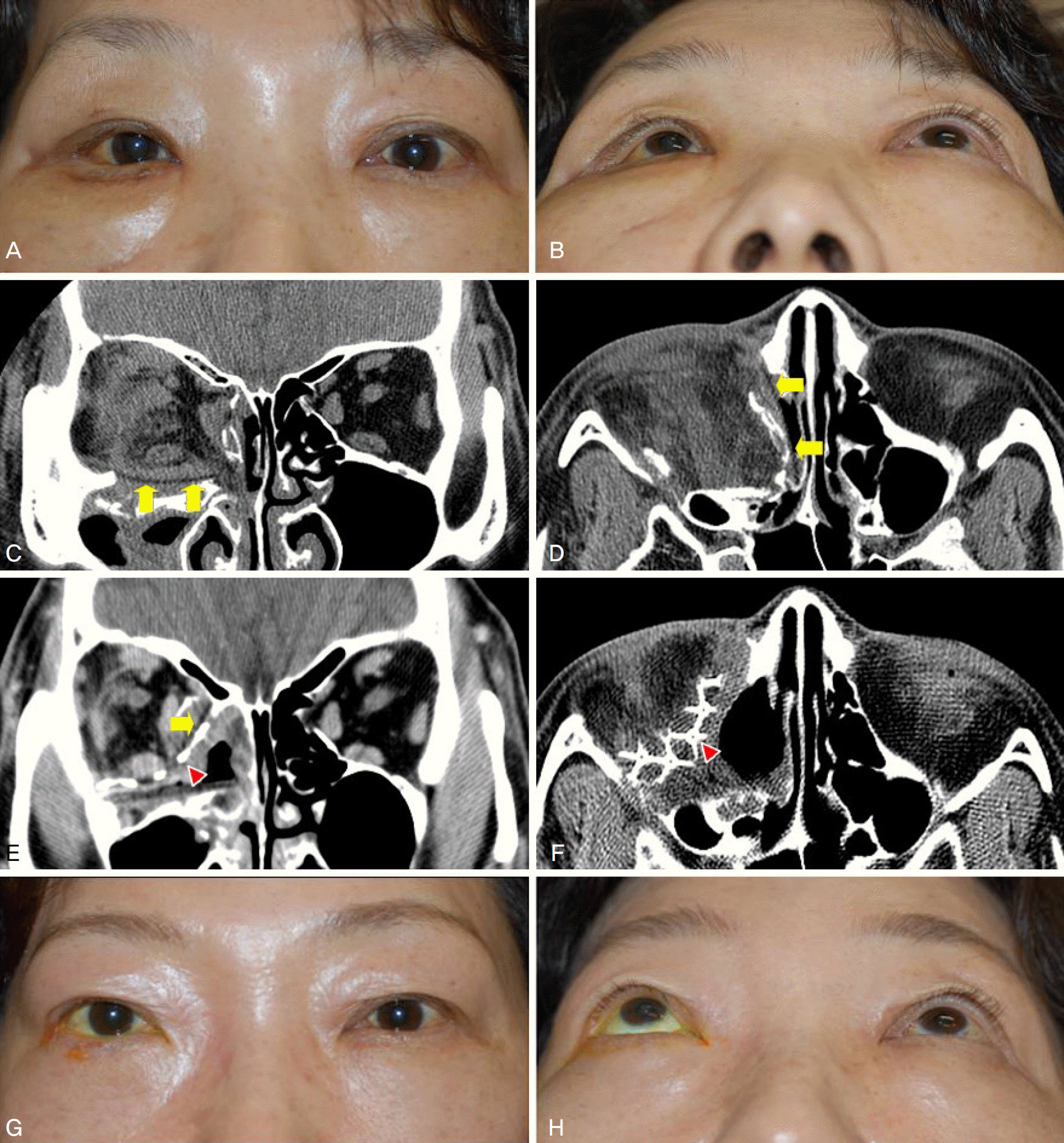Abstract
Purpose:
We present our experience with porous polyethylene/titanium implants in large orbital fractures that are difficult to repair with conventional orbital implants.
Methods:
A retrospective analysis was performed on seven patients who underwent repair of orbital fractures using porous polyethylene/titanium implants from September 2005 to December 2007.
Results:
The average age of the seven patients was 33.3 years, including two males and five females. The mean follow-up period was 5.4 months. Six cases had combined medial and inferior wall fractures, and one case had a large inferior wall fracture. Fractures were all large enough to encompass over 50% of the associated walls. After surgery, ocular motility disturbance and diplopia improved significantly. Enophthalmos improved from a mean of 2.9 mm to 0.6 mm postoperatively. No complications occurred such as visual loss, implant exposure or migration, or orbital infection.
Go to : 
References
1. Biesman BS, Hornblass A, Lisman R, Kazlas M. Diplopia after surgical repair of orbital floor fractures. Ophthal Plast Reconstr Surg. 1996; 12:9–16.

2. Freeman BS. The direct approach to acute fractures of the zygomatic-maxillary complex and immediate prosthetic replacement of the orbital floor. Plast Reconstr Surg Transplant Bull. 1962; 29:587–95.

3. Goldman RJ, Hessburg PC. The Caldwell-Luc procedure to correct orbital floor fractures. Ann Ophthalmol. 1973; 5:1259–60.
4. Converse JM, Firmin F, Wood-Smith D, Friedland JA. The conjunctival approach in orbital fractures. Plast Reconstr Surg. 1973; 52:656–7.

5. Garibaldi DC, Iliff NT, Grant MP, Merbs SL. Use of porous polyethylene with embedded titanium in orbital reconstruction: a review of 106 patients. Ophthal Plast Reconstr Surg. 2007; 23:439–44.

6. Gear AJ, Lokeh A, Aldridge JH, et al. Safety of titanium mesh for orbital reconstruction. Ann Plast Surg. 2002; 48:1–7.

7. Sargent LA, Fulks KW. Reconstruction of internal orbital fractures with vitallium mesh. Plast Reconstr Surg. 1991; 88:31–8.

8. Glassman RD, Manson PN, Markowitz B, et al. Rigid fixation of orbital fractures. Plast Reconstr Surg. 1990; 86:1103–9.
9. Katou F, Andoh N, Motegi K, Nagura H. Immuno-inflammatory responses in the tissue adjacent to titanium miniplates used in the treatment of mandibular fractures. J Craniomaxillofac Surg. 1996; 24:155–62.

10. Wellisz T. Clinical experience with the Medpor porous polyethylene implant. Aesth Plast Surg. 1993; 339–44.

11. Kim BJ, Kim YD. Porous polyethylene (MedporⓇ) channel implants in orbital fracture repairs. J Korean Ophthalmol Soc. 2002; 43:1238–49.
12. Park HS, Kim YK, Yoon CH. Various applications of titanium mesh screen implant to orbital wall fractures. J Craniofac Surg. 2001; 12:555–60.

13. Barry LE. Alloplastic implantation. Plast Reconstr Surg. 1999; 104:1761–83.
14. Fiala TG, Novelline RA, Yeremchuk MJ. Comparison of CT imaging artifact from craniomaxillo facial internal fixation devices. Plast Reconstr Surg. 1993; 92:1227–32.
Go to : 
 | Figure 1.The porous polyethylene/titanium implants consist of two sheets of porous polyethylene embedded with a thin titanium mesh. |
 | Figure 3.This 20-year-old female presented with facial deformity after a fall 10 days before surgery. (A, B) Note severe enophthalmos (6 mm) on preoperative photographs. Her ocular motility was severely restricted in all directions. (C, D) Preoperative coronal CT scans reveal large inferior and medial wall fractures extending to the posterior portion with two big bony fragments displaced into the adjacent sinuses. (E, F) Postoperative photographs (4 months) demonstrate resolution of enophthalmos. Ocular motility also improved. |
 | Figure 4.This 54-year-old female presented with diplopia and right enophthalmos following a motor vehicle collision 8 weeks prior to presentation. She had undergone initial orbital reconstruction elsewhere. (A, B) Preoperative photographs showing enophthalmos (5 mm) and generalized limitation of motility in the right eye. (C, D) Preoperative CT scans disclose large medial wall and floor fractures with herniation of orbital contents and displacement of implants (yellow arrows) into the adjacent sinuses. (E, F) Postoperative CT scans taken after 9 months confirm good placement of implants. Her enophthalmos resolved and ocular motility was almost full, except minimal restriction and diplopia on far upgaze. (G, H) Postoperative photographs taken after 2 years demonstrate the good restoration of orbital volume and symmetry. (red arrowheads=MedporⓇ Titan implant; yellow arrow=MedporⓇ Barrier sheet) |
Table 1.
Summary of 7 patients treated for large orbital fractures with porous polyethylene/titanium implants
| Age(yrs)/Sex | Cause | Surgery delay (days) | Follow-up (months) | Inferior implants | Medial implants | |
|---|---|---|---|---|---|---|
| Patient 1 | 33/M | Assault | 18 | 3 | MTB∗1 | MTB∗1 |
| Patient 2 | 41/F | Fall | 14 | 5 | MTB∗1 | |
| Patient 3 | 20/F | Fall | 10 | 4 | MTB∗1 | MTB∗1 |
| Patient 4 | 23/F | Stick | 11 | 7 | MTB∗1 | |
| Patient 5 | 44/F | Stick | 12,045 | 4 | W†1 | MTB∗1 |
| Patient 6 | 54/F | Accident | 60 | 10 | MTB∗1, MC‡1 | MTB∗1, MB§1 |
| Patient 7 | 18/M | Assault | 19 | 5 | MTB∗1 | MB§1 |
Table 1.
Cont'd
| Diplopia | Gaze restrictions | Enophthalmos (mm) | Infraorbital hypesthesia | Complications | |||||
|---|---|---|---|---|---|---|---|---|---|
| Preop | Postop | Preop | Postop | Preop | Postop | Preop | Postop | ||
| Patient 1 | + | - | Moderate# | - | 3 | 1 | + | - | - |
| Patient 2 | + | - | Moderate# | - | 0 | 0 | + | - | - |
| Patient 3 | - | - | Severe‡ | Moderate# | 6 | 2 | + | - | - |
| Patient 4 | + | - | Moderate# | - | 2 | 0 | + | - | - |
| Patient 5 | - | - | - | - | 2 | 0 | - | - | - |
| Patient 6 | + | Improved∏ | Severe∗∗ | - | 5 | 0 | + | - | Sinus bleeding |
| Patient 7 | + | - | Moderate# | - | 2.5 | 1 | + | - | - |




 PDF
PDF ePub
ePub Citation
Citation Print
Print


 XML Download
XML Download